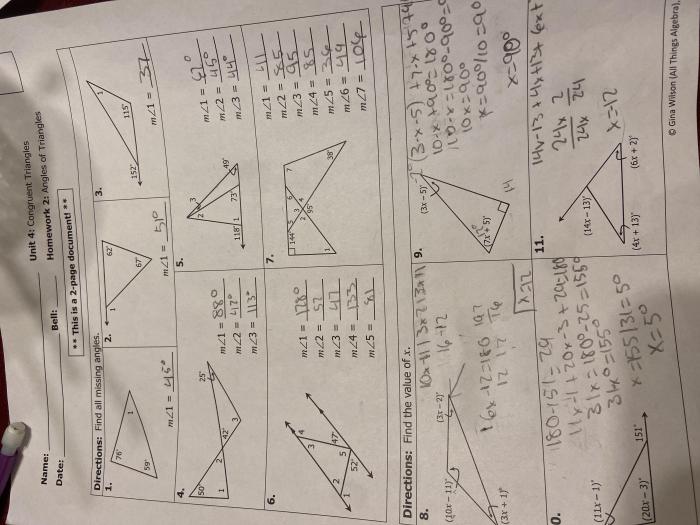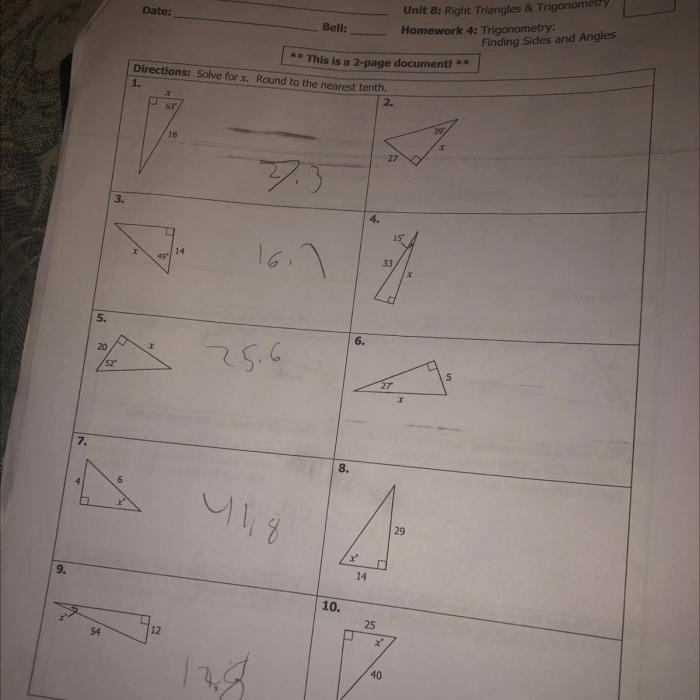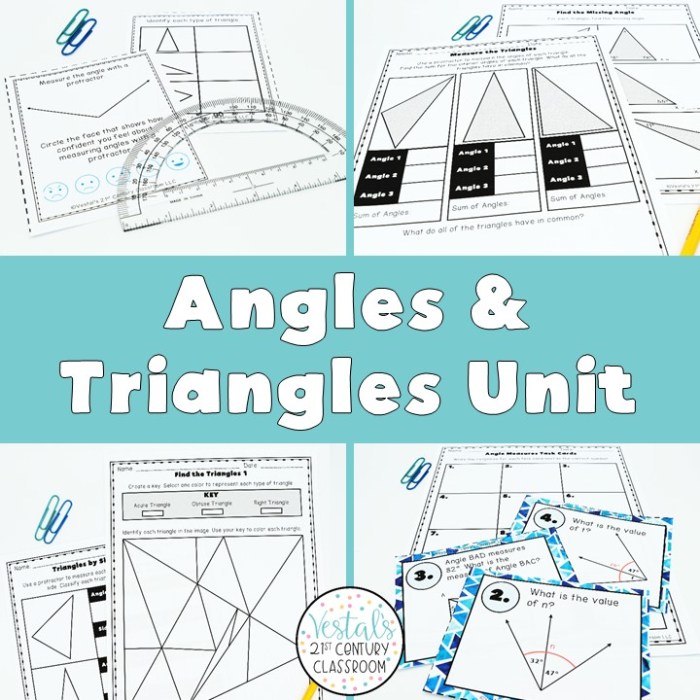Welcome to the comprehensive Angles and Triangles Unit Study Guide, an authoritative resource that unravels the intricacies of geometry’s building blocks. Prepare to embark on an enlightening journey through the fascinating world of angles and triangles, where every discovery unlocks a new layer of understanding in architecture, engineering, and beyond.
This guide meticulously dissects the concept of angles, their measurement, and various classifications. It illuminates the properties of triangles, including their side and angle-based distinctions. Delve into the captivating world of geometric constructions, mastering techniques for angle construction and triangle creation.
Definitions and Properties of Angles: Angles And Triangles Unit Study Guide

An angle is a figure formed by two rays or line segments that share a common endpoint, called the vertex. The measurement of an angle is expressed in degrees, with one complete rotation measuring 360 degrees.
Angles are classified into various types based on their measure:
Types of Angles
- Acute angle:An angle measuring less than 90 degrees.
- Obtuse angle:An angle measuring greater than 90 degrees but less than 180 degrees.
- Right angle:An angle measuring exactly 90 degrees.
- Straight angle:An angle measuring exactly 180 degrees.
- Reflex angle:An angle measuring greater than 180 degrees but less than 360 degrees.
Properties of Angles
Angles possess certain properties that are useful in geometric calculations:
- Supplementary angles:Two angles whose sum is 180 degrees.
- Complementary angles:Two angles whose sum is 90 degrees.
- Vertical angles:Two non-adjacent angles formed by two intersecting lines, which are equal in measure.
- Adjacent angles:Two angles that share a common side and a common vertex.
Classifying Triangles

A triangle is a three-sided polygon with three vertices and three edges. It is one of the basic shapes in geometry and has a variety of properties.
Triangles can be classified into different types based on the length of their sides and the measure of their angles.
Types of Triangles Based on Sides, Angles and triangles unit study guide
Based on the length of their sides, triangles can be classified into three types:
- Equilateral triangle:A triangle with all three sides equal in length.
- Isosceles triangle:A triangle with two sides equal in length.
- Scalene triangle:A triangle with all three sides different in length.
Types of Triangles Based on Angles
Based on the measure of their angles, triangles can be classified into three types:
- Acute triangle:A triangle with all three angles less than 90 degrees.
- Obtuse triangle:A triangle with one angle greater than 90 degrees.
- Right triangle:A triangle with one angle equal to 90 degrees.
Angle Relationships in Triangles

In geometry, understanding the relationships between angles within a triangle is crucial. This section explores two fundamental theorems that govern these relationships: the angle sum theorem and the exterior angle theorem.
Angle Sum Theorem
The angle sum theorem states that the sum of the interior angles of a triangle is always 180 degrees. This theorem holds true for all triangles, regardless of their size or shape. The angle sum theorem has important implications for triangle construction and analysis.
Exterior Angle Theorem
The exterior angle theorem states that the measure of an exterior angle of a triangle is equal to the sum of the measures of the two opposite interior angles. This theorem is useful for determining the measure of an exterior angle when the measures of the two opposite interior angles are known.
Relationship between Interior and Exterior Angles
The relationship between the interior and exterior angles of a triangle is determined by the angle sum theorem. If the sum of the interior angles of a triangle is 180 degrees, then the sum of the exterior angles must also be 180 degrees.
This relationship is useful for determining the measure of an exterior angle when the measures of the interior angles are known, or vice versa.
Geometric Constructions

Geometric constructions are a set of techniques used to create geometric figures accurately using tools such as a compass and a straightedge. These constructions are essential in various fields, including geometry, engineering, and architecture.
Constructing Angles Using a Protractor
A protractor is a semicircular tool used to measure and construct angles. To construct an angle using a protractor:
- Place the center of the protractor on the vertex of the angle.
- Align the 0-degree mark with one ray of the angle.
- Mark the desired angle measure on the protractor.
- Draw a ray from the vertex through the mark to form the second ray of the angle.
Constructing Equilateral and Isosceles Triangles Using a Compass and Straightedge
-*Equilateral Triangle
– Draw a circle with any radius using a compass. – Mark three points on the circle as vertices A, B, and C. – Join the vertices to form an equilateral triangle ABC.
-*Isosceles Triangle
– Draw a line segment of any length. – Mark a point on the line segment as the vertex A. – Set the compass to half the length of the line segment. – With A as the center, draw two arcs intersecting the line segment at points B and C.
– Join the vertices A, B, and C to form an isosceles triangle ABC.
Applications of Geometric Constructions in Real-World Applications
Geometric constructions have numerous applications in real-world scenarios, including:
-
-*Architecture
Designing buildings, bridges, and other structures requires accurate geometric constructions to ensure stability and aesthetics.
-*Engineering
Engineers use geometric constructions to design machinery, vehicles, and other objects with precise dimensions and angles.
-*Surveying
Geometric constructions are used to measure distances, angles, and areas of land for mapping and construction purposes.
-*Art and Design
Artists and designers use geometric constructions to create visually appealing patterns, shapes, and compositions.
Applications of Angles and Triangles

Angles and triangles are fundamental concepts in geometry with a wide range of applications in various fields, including architecture, engineering, design, navigation, and surveying. These applications rely on the principles of geometry to solve problems and design structures.
Architecture and Engineering
In architecture and engineering, angles and triangles are used to design and construct buildings, bridges, and other structures. Architects and engineers use geometric principles to calculate the angles of roofs, the strength of beams, and the stability of bridges. Triangles are particularly important in truss structures, which are used to support roofs and bridges because of their strength and stability.
Design
Angles and triangles are also used in design, including graphic design, interior design, and fashion design. Graphic designers use angles and triangles to create logos, posters, and other visual designs. Interior designers use angles and triangles to design furniture, room layouts, and lighting schemes.
Fashion designers use angles and triangles to create clothing patterns and accessories.
Navigation and Surveying
Angles and triangles are essential in navigation and surveying. Navigators use angles to determine the direction of travel and the distance to a destination. Surveyors use angles and triangles to measure land areas, create maps, and determine property boundaries.
Frequently Asked Questions
What is the angle sum theorem for triangles?
The angle sum theorem states that the sum of the interior angles of a triangle is always 180 degrees.
How do I construct an equilateral triangle using a compass and straightedge?
To construct an equilateral triangle, follow these steps:
- Draw a line segment of any length.
- Place the compass point at one endpoint of the line segment and draw an arc that intersects the line segment at two points.
- Without changing the compass width, place the compass point at one of the intersection points and draw another arc that intersects the first arc.
- Connect the three intersection points to form an equilateral triangle.
What are the applications of angles and triangles in real-world scenarios?
Angles and triangles have numerous applications in real-world scenarios, including:
- Architecture: Designing buildings, bridges, and other structures.
- Engineering: Designing machines, vehicles, and other products.
- Navigation: Determining the location of ships, airplanes, and other vehicles.
- Surveying: Measuring land areas and distances.